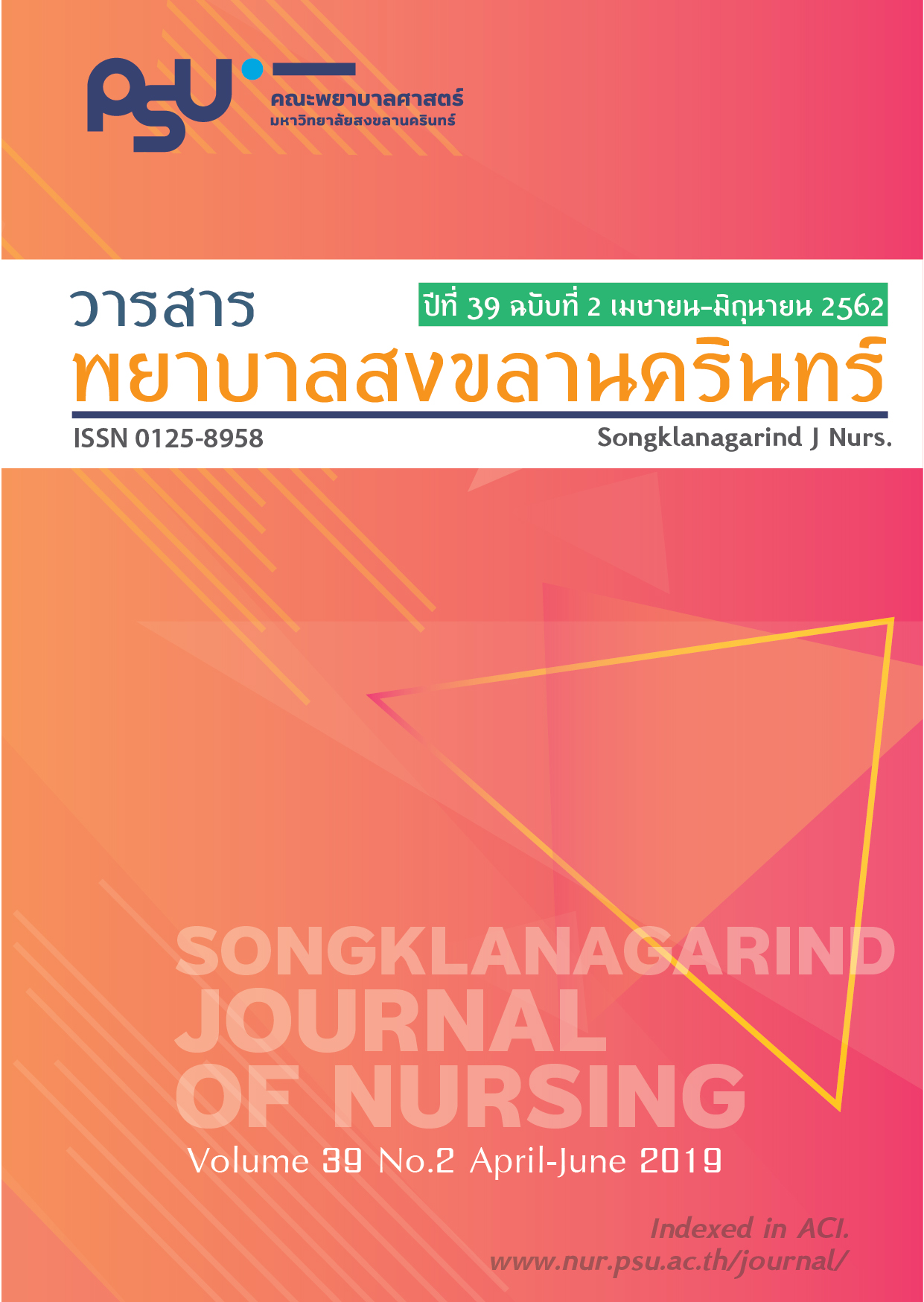การพัฒนาสมรรถนะการสื่อสารเพื่อส่งต่อข้อมูลทางการพยาบาล โดยใช้บทเรียนออนไลน์สำหรับนักศึกษาพยาบาล
Main Article Content
บทคัดย่อ
การวิจัยนี้มีวัตถุประสงค์ เพื่อพัฒนาและประเมินผลบทเรียนออนไลน์การพัฒนาสมรรถนะการสื่อสารเพื่อส่งต่อข้อมูลทางการพยาบาล มีวิธีดำเนินการวิจัย 3 ระยะ ได้แก่ 1) ศึกษาสภาพการณ์และแนวทางการพัฒนาสมรรถนะการสื่อสาร เพื่อส่งต่อข้อมูลทางการพยาบาล ผู้ให้ข้อมูลเป็นอาจารย์พยาบาล 7 คน และนักศึกษาพยาบาล 8 คน เก็บรวบรวมข้อมูล โดยการสนทนากลุ่ม วิเคราะห์ข้อมูลโดยการวิเคราะห์เนื้อหา 2) สร้างบทเรียนออนไลน์ฯ ซึ่งผ่านการตรวจสอบโดยผู้เชี่ยวชาญ 5 คน และ 3) ศึกษาผลของบทเรียนออนไลน์ฯ โดยการวิจัยกึ่งทดลอง กลุ่มตัวอย่างเป็นนักศึกษาพยาบาล 24 คน เก็บรวบรวมข้อมูล โดยใช้แบบสอบถามสมรรถนะการสื่อสารเพื่อส่งต่อข้อมูลทางการพยาบาล วิเคราะห์ข้อมูลโดยใช้สถิติพรรณนา และการทดสอบทีแบบไม่เป็นอิสระต่อกัน ผลการวิจัย สามารถสรุปได้ ดังนี้การวิจัยนี้มีวัตถุประสงค์ เพื่อพัฒนาและประเมินผลบทเรียนออนไลน์การพัฒนาสมรรถนะการสื่อสารเพื่อส่งต่อข้อมูลทางการพยาบาล มีวิธีดำเนินการวิจัย 3 ระยะ ได้แก่ 1) ศึกษาสภาพการณ์และแนวทางการพัฒนาสมรรถนะการสื่อสาร เพื่อส่งต่อข้อมูลทางการพยาบาล ผู้ให้ข้อมูลเป็นอาจารย์พยาบาล 7 คน และนักศึกษาพยาบาล 8 คน เก็บรวบรวมข้อมูล โดยการสนทนากลุ่ม วิเคราะห์ข้อมูลโดยการวิเคราะห์เนื้อหา 2) สร้างบทเรียนออนไลน์ฯ ซึ่งผ่านการตรวจสอบโดยผู้เชี่ยวชาญ 5 คน และ 3) ศึกษาผลของบทเรียนออนไลน์ฯ โดยการวิจัยกึ่งทดลอง กลุ่มตัวอย่างเป็นนักศึกษาพยาบาล 24 คน เก็บรวบรวมข้อมูล โดยใช้แบบสอบถามสมรรถนะการสื่อสารเพื่อส่งต่อข้อมูลทางการพยาบาล วิเคราะห์ข้อมูลโดยใช้สถิติพรรณนา และการทดสอบทีแบบไม่เป็นอิสระต่อกัน ผลการวิจัย สามารถสรุปได้ ดังนี้
1. บทเรียนออนไลน์การสื่อสารเพื่อส่งต่อข้อมูลทางการพยาบาลด้วยเทคนิคไอเอสบาร์ มีกระบวนการเรียนการสอน 3 ขั้นตอน ได้แก่ 1) เตรียมผู้เรียน เป็นการปฐมนิเทศขั้นตอนการใช้บทเรียน และการทดสอบก่อนเรียน 2) เรียนรู้และสะท้อนคิดเป็นการเรียนรู้เนื้อหาภาคทฤษฎีและฝึกปฏิบัติการสื่อสารเพื่อส่งต่อข้อมูลทางการพยาบาลด้วยเทคนิคไอเอสบาร์ โดยใช้สถานการณ์ทางคลินิก และจัดการเรียนการสอนตามแนวคิดการปฏิบัติอย่างตั้งใจ และ 3) ประเมินผล โดยการวัดสมรรถนะการสื่อสารเพื่อส่งต่อข้อมูลทางการพยาบาล หลังการใช้บทเรียนออนไลน์
2. นักศึกษาพยาบาลมีคะแนนเฉลี่ยสมรรถนะการสื่อสารเพื่อส่งต่อข้อมูลทางการพยาบาล หลังการใช้บทเรียนออนไลน์สูงกว่าก่อนการใช้บทเรียน อย่างมีนัยสำคัญทางสถิติ (t=9.39, p< .05)
จากผลการวิจัยนี้แสดงให้เห็นว่า บทเรียนออนไลน์ มีประโยชน์ในการพัฒนาสมรรถนะการสื่อสารเพื่อส่งต่อข้อมูลทางการพยาบาล อย่างไรก็ตาม การนำบทเรียนฯ ไปประยุกต์ใช้ ควรสร้างสถานการณ์คลินิกที่เหมาะสม สอดคล้องกับความต้องการและบริบทที่นำไปใช้ในการพัฒนาสมรรถนะการสื่อสาร เพื่อส่งต่อข้อมูลทางการพยาบาล
Article Details
เอกสารอ้างอิง
Paothipchan K, Pinchaleaw D, Puttapitukpol S. The relationships between communication skills, safety competency, and patient safety management of staff nurses at an autonomous university hospital in Bangkok metropolis. JOPN. 2015; 7 (1): 210-22. Thai.
Beckett C, Kipnis G. Collaborative communication: Integrating SBAR to improve quality/patient safety outcomes. J Healthc Qual. 2009; 31(5): 19-28.
Cornell P, Townsend-Gervis M, Yates L, et al. Improving shift report focus and consistency with the situation, background, assessment, recommendation protocol. J Nurs Adm. 2013; 3 (7/8): 422-8. doi: 10.1097/NNA.0b013e31829d6303.
Thomas C, Bertram E, Johnson D. The SBAR communication technique: Teaching nursing students professional communication skills. Nurse Educ. 2009; 34(4): 176-80. doi: 10.1097/NNE.0b013e3181aaba54.
Institute for Healthcare Improvement. SBAR: Situation-background-assessment recommendation. [Internet]. Boston: 2017 [cited 2018 Oct 10]. Available from: https://www.lsqin.org/wp-content/uploads/2017/08/SBARTechniqueforCommunication.pdf
Saied H, James J, Singh EJ, et al. Clinical evaluation of baccalaureate nursing students using SBAR format: Faculty versus self evaluation. JEP. 2016; 7(11): 9-13.
Yu M, Kang K. SBAR report competency and communication clarity of handover in Korean nursing students. IJBSBT. 2015; 7(6): 189-200.
Cornell P, Townsend-Gervis M, Yates L, et al. Impact of SBAR on nurse shift reports and staff rounding. Medsurg Nurs. 2014; 23(5): 334-42.
Fay-Hillier TM, Regan RV, Gordon MG. Communication and patient safety in simulation for mental health nursing education. Issues Ment Health Nurs. 2012; 33(11): 718-26. doi: 10.3109/01612840.2012.709585.
Finnigan MA, Marshall SD, Flanagan BT. ISBAR for clear communication: One hospital’s experience spreading the message. Aust Health Rev. 2010; 34(4): 400-4. doi: 10.1071/AH09823.
Enlow M, Shanks L, Guhde J, et al. Incorporating interprofessional communication skills (ISBARR) into an undergraduate nursing curriculum. Nurse Educ. 2010; 35(4): 176-80. doi: 10.1097/NNE.0b013e3181e339ac.
Charuwanno R, Wongchanglor J, Pongsananurak T. Effects of teaching by using SBAR technique on knowledge attitude and practice in taking and giving report among nursing. JRTAN. 2014; 15 (3): 390-7. Thai.
Pantaewan P. Development of students in the 21st century with active learning in nursing profession. JRTAN. 2016; 17(3): 17-24. Thai.
Kanhadilok S, Punsumreung T. Simulation based learning: Design for nursing education. JNAE. 2016; 9(1): 1-14. Thai.
Suwannakeeree W, Jullmusi O, Tangkawanich T. Simulation-based learning management for nursing students. JNSCU. 2016; 28(2): 1-14. Thai.
Chantian P, Saard S, von Bormann S, et al. The development of an e-learning program to prepare nursing students of Phraboromarajchanok institute for health workforce development in response to the ASEAN community. TNAPH. 2016; 26(2): 154-65. Thai.
Ericsson KA, Whyte J, Ward P. Expert performance in nursing: Reviewing research on expertise in nursing within the framework of the expert-performance approach. ANS Adv. Nurs Sci. 2007; 30(1): 58-71.
Whyte J, Cormier E. A deliberate practice-based training protocol for student nurses care of the critically ill patient: A randomized controlled trial of a deliberate practice-based training protocol. Clin Simul Nurs. 2014; 10 (12): 617-25.
Thammetar T. E-Learning: From theory to practice. Bangkok: Thailand Cyber University Project. 2014. Thai.
Patton MQ. Qualitative research & evaluation methods: Integrating theory and practice (4th ed.). California: SAGE. 2015.
Srisamran P, Wisedsing K, Tantiwarasakool K. The development of model of nursing change of shift report at Banpong hospital. REG45. 2018; 37(3): 238-50. Thai.
Faul F, Erdfelder E, Lang AG, et al. G*Power 3: A flexible statistical power analysis program for the social, behavioral, and biomedical sciences. Behav Res Methods. 2007; 39(2): 175-91.
Cohen J. Statistical power analysis for the behavioral sciences (2nd ed.). New Jersey: Lawrence Erlbaum Associates.1988.
Srisa-ard B. Basic research (9th ed.) Bangkok: Suwiriyasarn. 2013. Thai.
Collins G. Using simulation to develop handover skills. Nurs Times. 2014; 110(8): 12-4.
Wang W, Liang Z, Blazeck A, et al. Improving Chinese nursing students’ communication skills by utilizing video-stimulated recall and role-play case scenarios to introduce them to the SBAR technique. Nurse Educ Today. 2015; 35(7): 881-7.
Yu M, Kang K. Effectiveness of a role-play simulation program involving the SBAR technique: A quasi-experimental study. Nurse Educ Today. 2017; 53: 41-7. doi: 10.1016/j.nedt.2017.04.002.


